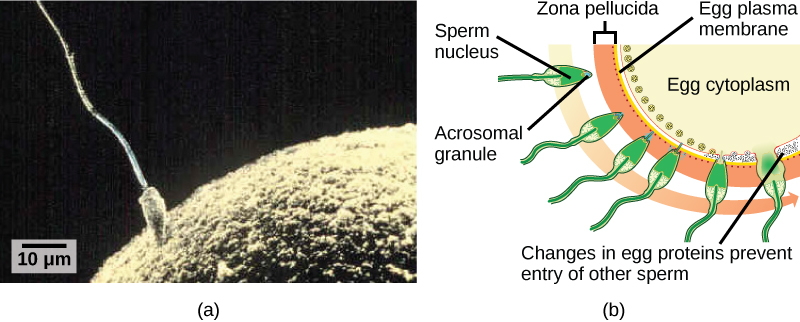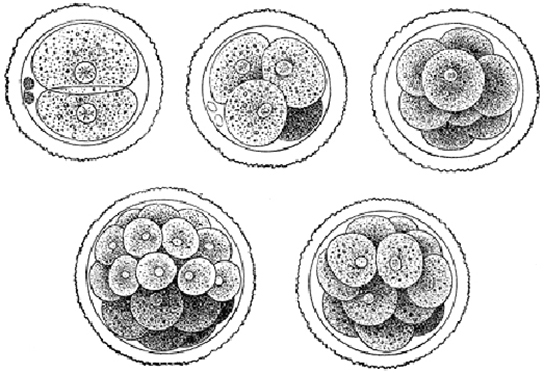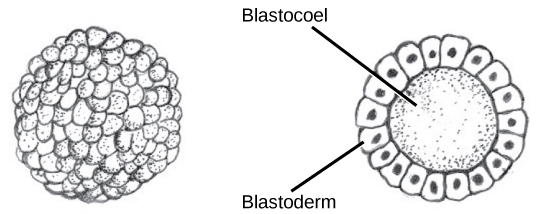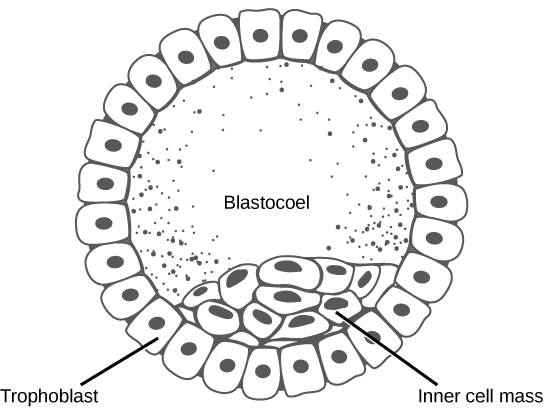43.6: Mbolea na Maendeleo ya Mapema ya Embryonic
- Page ID
- 175820
Ujuzi wa Kuendeleza
- Jadili jinsi mbolea hutokea
- Eleza jinsi kijana huunda kutoka kwa zygote
- Jadili jukumu la usafi na gastrulation katika maendeleo ya wanyama
Mchakato ambao kiumbe kinaendelea kutoka kwa zygote moja-celled kwa viumbe mbalimbali vya seli ni ngumu na vizuri umewekwa. Hatua za mwanzo za maendeleo ya embryonic pia ni muhimu kwa kuhakikisha fitness ya viumbe.
Mbolea
Mbolea, picha katika Mchoro\(\PageIndex{1}\) a ni mchakato ambao gametes (yai na mbegu) fuse kuunda zygote. Yai na mbegu za kiume kila mmoja zina seti moja ya chromosomes. Ili kuhakikisha kwamba watoto wana seti moja tu ya diploid kamili ya chromosomes, mbegu moja tu inapaswa kuunganisha na yai moja. Katika mamalia, yai inalindwa na safu ya tumbo la ziada linalojumuisha hasa ya glycoproteins inayoitwa zona pellucida. Wakati mbegu hufunga kwa zona pellucida, mfululizo wa matukio ya biochemical, inayoitwa athari za acrosomal, hufanyika. Katika mamalia kondo acrosome ina Enzymes utumbo kwamba kuanzisha uharibifu wa matrix glycoprotein kulinda yai na kuruhusu mbegu plasma utando fyuzi na yai plasma membrane, kama inavyoonekana katika Kielelezo\(\PageIndex{1}\) b. fusion ya utando hizi mbili inajenga ufunguzi kupitia ambayo kiini cha mbegu huhamishiwa ndani ya ovum. Vipande vya nyuklia vya yai na mbegu huvunjika na genomu mbili za haploidi hufungia kuunda genome ya diploidi.

Ili kuhakikisha kuwa hakuna mbegu zaidi ya moja inayozalisha yai, mara moja athari za acrosomal hufanyika mahali pekee ya membrane ya yai, yai hutoa protini katika maeneo mengine ili kuzuia mbegu nyingine kutoka kwa fusing na yai. Ikiwa utaratibu huu unashindwa, mbegu nyingi zinaweza kuunganisha na yai, na kusababisha polispermy. Mtoto unaosababishwa hauna faida na hufa ndani ya siku chache.
cleavage na Blastula hatua
Maendeleo ya viumbe mbalimbali vya seli huanza kutoka zygote moja-seli, ambayo inakabiliwa na mgawanyiko wa seli haraka ili kuunda blastula. Mzunguko wa haraka, nyingi wa mgawanyiko wa seli huitwa cleavage. Cleavage inaonyeshwa katika (Kielelezo\(\PageIndex{2}\) a). Baada ya mpasuko kuzalisha seli zaidi ya 100, kiinitete huitwa blastula. Blastula kwa kawaida ni safu ya spherical ya seli (blastoderm) inayozunguka cavity iliyojaa maji au yolk-kujazwa (blastocoel). Mamalia katika hatua hii huunda muundo unaoitwa blastocyst, unaojulikana kwa molekuli ya ndani ya seli ambayo ni tofauti na blastula inayozunguka, inavyoonekana kwenye Kielelezo\(\PageIndex{2}\) b Wakati wa cleavage, seli hugawanyika bila kuongezeka kwa wingi; yaani, zygote moja kubwa ya seli moja hugawanyika katika seli nyingi ndogo . Kila kiini ndani ya blastula huitwa blastomere.


Cleavage inaweza kufanyika kwa njia mbili: holoblastic (jumla) cleavage au meroblastic (sehemu) cleavage. Aina ya cleavage inategemea kiasi cha yolk katika mayai. Katika mamalia ya kondo (ikiwa ni pamoja na binadamu) ambako chakula hutolewa na mwili wa mama, mayai yana kiasi kidogo sana cha yolk na hupata mpasuko wa holoblastic. Spishi nyingine, kama vile ndege, zenye pingu nyingi ndani ya yai ili kulisha kiinitete wakati wa maendeleo, hupitia cleavage ya meroblastic.
Katika mamalia, blastula huunda blastocyst katika hatua inayofuata ya maendeleo. Hapa seli katika blastula hujipanga katika tabaka mbili: molekuli ya ndani ya seli, na safu ya nje inayoitwa trophoblast. Masi ya seli ya ndani pia inajulikana kama embryoblast na molekuli hii ya seli itaendelea kuunda kiinitete. Katika hatua hii ya maendeleo, mfano katika Kielelezo ndani\(\PageIndex{3}\) kiini habari lina seli embryonic shina ambayo kutofautisha katika aina mbalimbali za seli zinahitajika kwa viumbe. Trophoblast itachangia kwenye placenta na kulisha kiinitete.

Unganisha na Kujifunza

Tembelea mradi wa Virtual Binadamu Embetric katika tovuti ya Endowment for Binadamu Development kupitia maingiliano ambayo inaonyesha hatua za maendeleo ya kiinitete, ikiwa ni pamoja na mikrographs na kupokezana picha 3-D.
Gastrulation
Blastula ya kawaida ni mpira wa seli. Hatua inayofuata katika maendeleo ya embryonic ni malezi ya mpango wa mwili. Seli katika blastula hujipanga upya kwa anga ili kuunda tabaka tatu za seli. Utaratibu huu unaitwa gastrulation. Wakati wa gastrulation, blastula inajikuta yenyewe ili kuunda tabaka tatu za seli. Kila moja ya tabaka hizi huitwa safu ya virusi na kila safu ya virusi hufafanua katika mifumo tofauti ya chombo.
Vidudu vitatu tabaka, inavyoonekana katika Kielelezo\(\PageIndex{4}\), are the endoderm, the ectoderm, and the mesoderm. The ectoderm gives rise to the nervous system and the epidermis. The mesoderm gives rise to the muscle cells and connective tissue in the body. The endoderm gives rise to columnar cells found in the digestive system and many internal organs.

Everyday Connection: Are Designer Babies in Our Future?

If you could prevent your child from getting a devastating genetic disease, would you do it? Would you select the sex of your child or select for their attractiveness, strength, or intelligence? How far would you go to maximize the possibility of resistance to disease? The genetic engineering of a human child, the production of "designer babies" with desirable phenotypic characteristics, was once a topic restricted to science fiction. This is the case no longer: science fiction is now overlapping into science fact. Many phenotypic choices for offspring are already available, with many more likely to be possible in the not too distant future. Which traits should be selected and how they should be selected are topics of much debate within the worldwide medical community. The ethical and moral line is not always clear or agreed upon, and some fear that modern reproductive technologies could lead to a new form of eugenics.
Eugenics is the use of information and technology from a variety of sources to improve the genetic makeup of the human race. The goal of creating genetically superior humans was quite prevalent (although controversial) in several countries during the early 20th century, but fell into disrepute when Nazi Germany developed an extensive eugenics program in the 1930's and 40's. As part of their program, the Nazis forcibly sterilized hundreds of thousands of the so-called "unfit" and killed tens of thousands of institutionally disabled people as part of a systematic program to develop a genetically superior race of Germans known as Aryans. Ever since, eugenic ideas have not been as publicly expressed, but there are still those who promote them.
Efforts have been made in the past to control traits in human children using donated sperm from men with desired traits. In fact, eugenicist Robert Klark Graham established a sperm bank in 1980 that included samples exclusively from donors with high IQs. The "genius" sperm bank failed to capture the public's imagination and the operation closed in 1999.
In more recent times, the procedure known as prenatal genetic diagnosis (PGD) has been developed. PGD involves the screening of human embryos as part of the process of in vitro fertilization, during which embryos are conceived and grown outside the mother's body for some period of time before they are implanted. The term PGD usually refers to both the diagnosis, selection, and the implantation of the selected embryos.
In the least controversial use of PGD, embryos are tested for the presence of alleles which cause genetic diseases such as sickle cell disease, muscular dystrophy, and hemophilia, in which a single disease-causing allele or pair of alleles has been identified. By excluding embryos containing these alleles from implantation into the mother, the disease is prevented, and the unused embryos are either donated to science or discarded. There are relatively few in the worldwide medical community that question the ethics of this type of procedure, which allows individuals scared to have children because of the alleles they carry to do so successfully. The major limitation to this procedure is its expense. Not usually covered by medical insurance and thus out of reach financially for most couples, only a very small percentage of all live births use such complicated methodologies. Yet, even in cases like these where the ethical issues may seem to be clear-cut, not everyone agrees with the morality of these types of procedures. For example, to those who take the position that human life begins at conception, the discarding of unused embryos, a necessary result of PGD, is unacceptable under any circumstances.
A murkier ethical situation is found in the selection of a child's sex, which is easily performed by PGD. Currently, countries such as Great Britain have banned the selection of a child's sex for reasons other than preventing sex-linked diseases. Other countries allow the procedure for "family balancing", based on the desire of some parents to have at least one child of each sex. Still others, including the United States, have taken a scattershot approach to regulating these practices, essentially leaving it to the individual practicing physician to decide which practices are acceptable and which are not.
Even murkier are rare instances of disabled parents, such as those with deafness or dwarfism, who select embryos via PGD to ensure that they share their disability. These parents usually cite many positive aspects of their disabilities and associated culture as reasons for their choice, which they see as their moral right. To others, to purposely cause a disability in a child violates the basic medical principle of Primum non nocere, "first, do no harm." This procedure, although not illegal in most countries, demonstrates the complexity of ethical issues associated with choosing genetic traits in offspring.
Where could this process lead? Will this technology become more affordable and how should it be used? With the ability of technology to progress rapidly and unpredictably, a lack of definitive guidelines for the use of reproductive technologies before they arise might make it difficult for legislators to keep pace once they are in fact realized, assuming the process needs any government regulation at all. Other bioethicists argue that we should only deal with technologies that exist now, and not in some uncertain future. They argue that these types of procedures will always be expensive and rare, so the fears of eugenics and "master" races are unfounded and overstated. The debate continues.
Summary
The early stages of embryonic development begin with fertilization. The process of fertilization is tightly controlled to ensure that only one sperm fuses with one egg. After fertilization, the zygote undergoes cleavage to form the blastula. The blastula, which in some species is a hollow ball of cells, undergoes a process called gastrulation, in which the three germ layers form. The ectoderm gives rise to the nervous system and the epidermal skin cells, the mesoderm gives rise to the muscle cells and connective tissue in the body, and the endoderm gives rise to columnar cells and internal organs.
Glossary
- acrosomal reaction
- series of biochemical reactions that the sperm uses to break through the zona pellucida
- blastocyst
- structure formed when cells in the mammalian blastula separate into an inner and outer layer
- gastrulation
- process in which the blastula folds over itself to form the three germ layers
- holoblastic
- complete cleavage; takes place in cells with a small amount of yolk
- inner cell mass
- inner layer of cells in the blastocyst
- meroblastic
- partial cleavage; takes place in cells with a large amount of yolk
- polyspermy
- condition in which one egg is fertilized by multiple sperm
- trophoblast
- outer layer of cells in the blastocyst
- zona pellucida
- protective layer of glycoproteins on the mammalian egg


